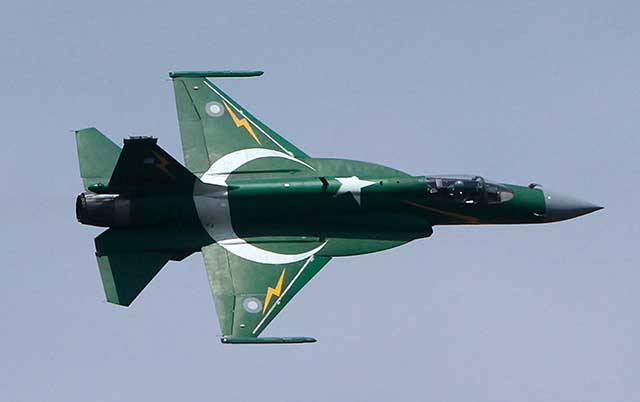PAF Fleet of 146 JF 17 Thunder programme may face trouble: international media report
Shares

During the 1990s, an intriguing shift occurred within the sphere of global military aviation. The Russian Mikoyan Design Bureau, renowned for its superior aircraft designs, found itself in an unexpected predicament. Rather than marketing its own aircraft across the globe as it had traditionally done, the bureau was compelled to relinquish its developments to the Chinese. This transfer of technology led to a significant collaboration between China and Pakistan, culminating in the commencement of production for the JF-17 Thunder fighter. [image: JF-17 fighter jet is important for Pakistan and can change the regional power (video)]Photo credit: AP
Intriguingly, the engine that resided within was an RD-93, a modified variant of the RD-33, the very lifeblood of the MiG-29. After a series of negotiations and deliberations, China ultimately secured the rights to manufacture the RD-93 on its own soil. The respective Russian corporation, in exchange for this concession, was remunerated a considerable sum, thus enabling its continued existence. Nevertheless, since those events transpired, a significant passage of time has occurred, with many changes unfolding in its wake.
The JF-17, widely recognized as the pivotal component of the Pakistan Air Force, maintains a robust presence, with 146 operational units currently in circulation. This particular model of fighter jet was originally crafted within the industrial confines of China. However, the production landscape underwent a significant transformation when a joint venture was subsequently initiated in Pakistan. This collaborative endeavor effectively facilitated the successful domestic manufacture of these formidable machines for an extended duration. [image: JF-17 approaches 4++: Pilot helmets have full awareness HMD display]Photo credit: Twitter
Currently, one could consider the JF-17 as outdated, yet it is critical to note that China has already advanced to the third modification of this model. This updated version significantly outperforms its predecessor in every aspect. Despite this, the earlier models of these fighters persist in service, for they retain their ability to accomplish the missions they are assigned to.
Contrary to initial expectations, a significant portion of the JF-17 was found to be non-operational. The root cause, as per expert analysis, was traced back to the Russian engine. It is critical to understand that, despite the engine itself being devoid of any inherent technical deficiencies, it does not negate the necessity for regular maintenance and service.
As reported by journalists from the EurAsian Times, Pakistani officials have made requests to their Chinese counterparts to commence maintenance on the engines. However, the reasons behind China’s reluctance to address the issue remain enigmatic. As time continues to elapse, the planes remain grounded, causing significant disruption. Consequently, the situation has elicited a response from the Russian Klimov UEC representatives, who have expressed their potential willingness to lend assistance to the Pakistani authorities.
In the vicinity where the RD-93 engine was brought into existence, a tangible opportunity presents itself for the initiation of spare parts production. However, a significant obstacle looms in the form of Rosoboronexport, the entity tasked with the sale of components, repair services, and various other duties, which currently languishes under the weight of US sanctions. The apprehension gripping the Pakistani authorities about potential secondary sanctions, should they opt to collaborate directly with Russia, is palpable. Consequently, the fighters remain grounded, despite the availability of spare parts, and the issue remains unresolved.
Photo credit: Pakistan Air Force
It is noteworthy to mention that the JF-17 “Thunder” boasts an impressive length of 14 meters and a wingspan stretching to 8.5 meters. The singularly installed power plant equips the jet with a substantial load capacity of 3,720 kilograms. The range for executing combat operations is capped at a considerable distance of 1,200 kilometers, although some sources suggest an extended reach of up to 1,350 kilometers.
With an impressive flight range that extends up to 3,000 kilometers on a single charge, the JF-17 “Thunder” exhibits unparalleled endurance. This robust fighter jet, boasting a maximum velocity of 1,900 km/h, is capable of ascending to an altitude of 15,200 meters, thus demonstrating its formidable aerial prowess.
The JF-17 “Thunder” is not only remarkable for its speed and range, but also for its versatile armament. It is equipped to carry an extensive array of weaponry, inclusive of both air-to-air and air-to-ground missiles. Additionally, it is capable of deploying aerial bombs, further enhancing its combat capabilities.
At present, the JF-17s are outfitted with the Chinese KLJ-10 radars and the SD-10 / PL-12 medium-range anti-aircraft missiles, possessing an active guidance system. As per the stipulations of the military-technical cooperation agreement with China, the initial batch of 50 fighters was supplied with Chinese radar systems. After this, the aircraft underwent a series of enhancements, integrating a blend of avionics and radars developed domestically in Pakistan, in conjunction with European radars.
In the past, the military of Pakistan was contemplating the acquisition of the RC-400 radar and MICA air-to-air missiles, commodities produced by the French firm, MBDA, a subsidiary of Thales. Additionally, talks were conducted with both British and Italian corporations to explore the potential for the provision of requisite equipment.
Source: Bulgarianmilitary.com
